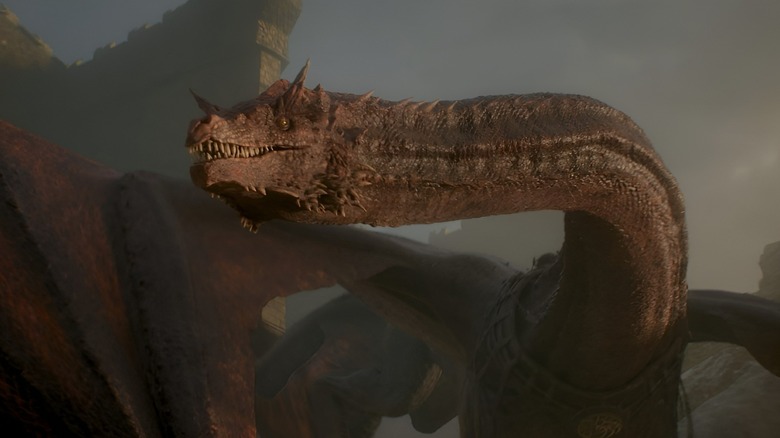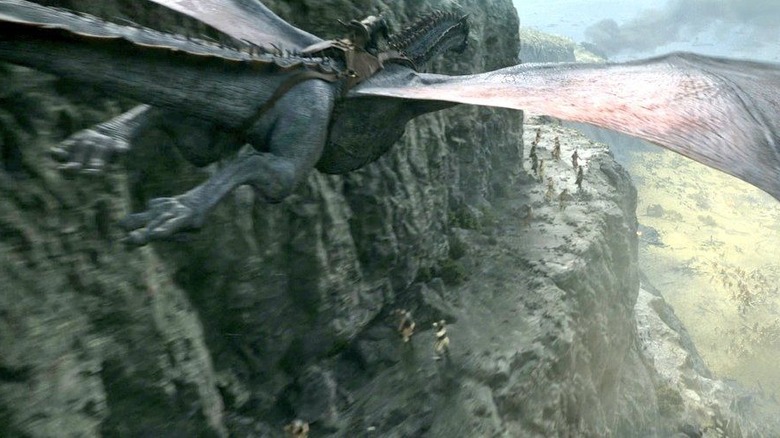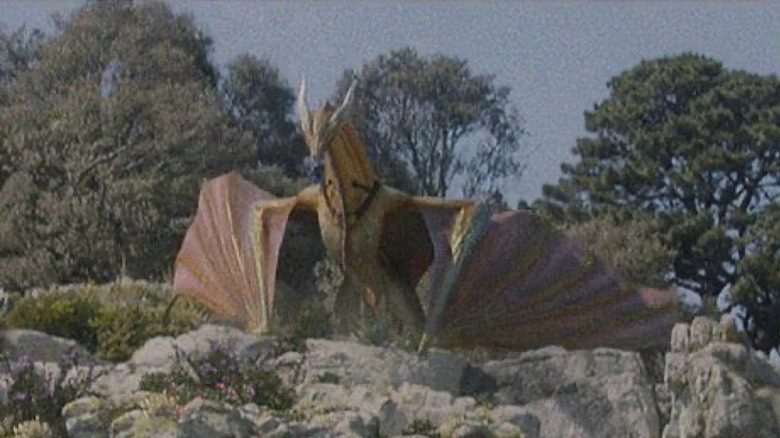Every Dragon From House Of The Dragon Season 1 Explained
HBO's first "Game of Thrones" prequel series has just as much interpersonal drama and palace intrigue as the original show, but there's one area in which this adaptation outdoes its predecessor: It's called "House of the Dragon," after all. While the title refers to the focus on House Targaryen and the civil war that breaks out about two centuries before the events of "Game of Thrones," it also refers to the fact that dragons were fairly commonplace at this time (spoiler alert: they never would be again).
Dragons numbered in the hundreds back in the days of Old Valyria, but there were still double digits of dragons flying around Westeros throughout the reigns of the first Targaryen monarchs. Showrunner Ryan Condal has said that there will be a total of 17 of them featured throughout the series' run, each with their own distinctive look, personality, and skill set. We get to meet several of these impressive beasts in the flesh in Season 1, plus one that's still worth mentioning, even though he's already passed. The non-human characters on "House of the Dragon" are so important to the story that they get their own section on the series' HBO homepage.
The visual effects required to bring dragons to life are expensive and time consuming, so they aren't exactly front and center in every scene, and they're easily confused with one another at times. If you found yourself struggling to make out the difference between the mounts of Rhaenyra, Daemon, Rhaenys, Laenor, and the rest of the Blacks and Greens, you aren't alone. Here's a rundown of every dragon from "House of the Dragon" Season 1. Spoilers ahead.
Balerion
Balerion the Black Dread is the most famous dragon in the history of Westeros; he's so important, he's mentioned in all but one of George R. R. Martin's Westeros-set books. We don't see him alive in "House of the Dragon," but his presence is still felt, and he's very much alive for several hundred pages of the source material. King Viserys first tells Rhaenyra that he intends to name her as his heir in front of a shrine to Balerion's massive skull in the candlelit catacombs. That's also where he reveals the details of Aegon's dream for the first time. The catspaw dagger on which the prophecy is etched represents a physical connection between Aegon the Conqueror and Viserys. So does Balerion.
According to Martin's books, Balerion was one of five dragons that flew with the Targaryens from Valyria to Westeros before the doom. He was born more than 100 years before Aegon's conquest and lived another 94 years after. Aegon rose to power on the back of the great black dragon, while Viserys was his final rider (in between, he was claimed by Aegon's children, Aerea and King Maegor I, aka Maegor the Cruel). Balerion was so big, his wingspan could block whole cities from the sun. He had black scales, breathed black fire that was hot enough to melt stone and metal, and had a mouthful of fangs as long and as sharp as swords. Balerion and Viserys only flew together once before the latter was king; the former was by then enormous, old, and weak.
Syrax
We first meet Syrax when a young Princess Rhaenyra swoops into the Dragonpit saddled up on her back. Later, when she rides to Dragonstone to confront Prince Daemon, she tells the men gathered there to be careful since Syrax is quite protective of her.
The show's depiction of Rhaenyra's dragon stays close to Martin's descriptions in "Fire & Blood;" in the text, Rhaenyra claims Syrax at the age of seven. It's implied that the dragon is relatively young and that the princess is her first rider. Rhaenyra and Syrax are extremely bonded and take to the skies together frequently (as such, the princess often reeks of dragon, as her mother and father both point out). The she-dragon is among the most domesticated in the Dragonpit. She doesn't mind being chained up and fed rather than being left loose to hunt on her own, but her lack of ferocity compared to some of the other Targaryen mounts could also be a liability.
As in the book, she's on the smaller side and covered in pale yellow scales with fronds or spikes that elegantly protrude from her head, almost like a crown. We know she's female because in both "Fire & Blood" and "House of the Dragon" she produces multiple clutches of eggs, including one just before the civil war known as the Dance of the Dragons begins.
Caraxes
Caraxes may not be the biggest, fastest, or best-looking dragon in Westeros, but he is the most fearsome. He's also the easiest to distinguish from the rest thanks to his serpentine neck. Prince Daemon's loyal steed first belonged to his uncle Aemon (father of Princess Rhaenys). Daemon's mother, Alyssa, taught him how to ride from the time he was an infant. The Rogue Prince claimed Caraxes as a young man after his uncle's death.
Caraxes became known as the Blood Wyrm because of his red scales, his long and lean body, and his aggressive temperament. He and Daemon — also tall, trim, and hot-tempered — are a good fit for each other. The prince uses Caraxes for leisure, travel, and battle. In the show, we see Daemon deploy him in an aerial attack on the Triarchy during a night battle in the Stepstones. Later, Daemon and Caraxes soar alongside Laena and Vhagar on a pleasure flight.
Caraxes is a valuable military asset. Though he doesn't rank first in any single stat, he's still one of the largest, quickest, and most experienced dragons in Westeros. His relationship with his rider and their shared will to win (and taste for violence) makes them a formidable pair. Vhagar is many, many times bigger than most other dragons in the Seven Kingdoms, but by the time of the Dance, Caraxes is nearly half her size, as well as much younger, nimbler, and more energetic.
Seasmoke
In the television series, Laenor Velaryon and his dragon Seasmoke are deciding factors in the Crown's victory over the Crabfeeder and the Triarchy (at least in the first phase of that ongoing conflict). Seasmoke is shown as a silvery gray-blue creature with a warm tint to his wings and what looks like the dragon equivalent of a goatee dangling from his chin. His head, chest, and tail are covered in short spikes that are slightly darker than the rest of his body. Seasmoke is noticeably smaller than Caraxes, but he's fast, agile, and incredibly bonded to his rider.
In "Fire & Blood," it's Laenor and not Rhaenys who is a claimant for the Iron Throne at the Great Council of 101 AC. That year, the boy — who was only seven — had claimed the young dragon Seasmoke for himself, which helped his cause. Viserys wasn't much of a dragonrider. Having only briefly ridden Balerion, he never mounted one again after the Black Dread's death. However, Laenor was yet to ride his own dragon, which made Seasmoke a moot point.
In short order, Seasmoke became Laenor's pride and joy. According to the book, after the Laenor's death, his dragon remained riderless at Dragonstone for about a decade until a character with Velaryon blood appeared to steer him back into battle. Since "House of the Dragon" has allowed Laenor to live, new theories have arisen to explain what might become of his beloved Seasmoke.
Meleys
Until Episode 9, audiences hadn't seen much of one of Westeros's most striking dragons, Meleys. You really had to squint to make out Princess Rhaenys upon her back in Episode 5. Then, at the end of "The Green Council," Meleys makes an entrance worthy of her nickname — the Red Queen — when she crashes Aegon II's coronation before Rhaenys makes her escape.
The Red Queen is one of the older living dragons in the book and on the show, though she's nowhere near as old as Vhagar. As "Fire & Blood" tells it, she was already mature and living in the Dragonpit in 75 AC when Viserys and Daemon's mother, Princess Alyssa, was the first to claim her. That means Viserys and Daemon both rode Meleys with their mother before they had dragons of their own. Rhaenys claimed Meleys two years after Alyssa died in childbirth, when the dragon was still at her peak. She flew her alongside her grandfather, King Jaehaerys, and his dragon, Vermithor, on diplomatic missions, and she even arrived at her wedding to Corlys Velaryon on the back of Meleys.
As we can see once she's face to face with the usurping Greens, Meleys has scarlet scales, rosy wings, and a crown of coppery black horns around her head. At one time, she may have been the fastest dragon in Westeros, but by the show's present day, she's showing her age. She's among the most battle-tested dragons remaining, however, and viewers should get to see more of her in this capacity in Season 2.
Vermax
The dragon of Prince Jacaerys Velaryon is part of a pivotal scene in Episode 6. The Dragonkeepers bring him out to continue the process of bonding Jace to Vermax, who looks to be quite young. Vermax isn't much larger than the boys themselves, and we can deduce that he probably hatched from an egg placed in Jace's crib. At this stage in his development, he's covered in pea-green scales and ruddy spikes connected by red membranes. But just because he's a manageable size doesn't mean he's easily manageable. Jace is both trepidatious and enthusiastic about interacting with his dragon. We see that Vermax follows the boy's commands (he's more than happy to oblige when Jace asks him to torch some livestock), but he still has plenty of attitude.
That Jace (or any of Rhaenyra's three brunette sons) has a dragon is a big deal. In the book, when rumors are swirling that the boys might be the children of Ser Harwin Strong rather than Laenor Velaryon, the fact that the egg in Jace's cradle actually hatches (especially when Aemond's does not) puts the gossip to rest for a time. It's also less obvious in "Fire & Blood" that Jace is Harwin's son since Rhaenys (like Harwin) has dark hair. The fact that the book version of Jace bonds so quickly with Vermax speaks to him being a true-born Targaryen.
Vhagar
In Episode 2, a 12-year-old Laena Velaryon (on an awkward first date of sorts with King Viserys) inquires about Vhagar, currently the oldest and biggest dragon in Westeros. Book readers knew this was a tease. In "Fire & Blood," Laena has already claimed Vhagar for herself that very same year, which was no small feat. The legendary dragon's previous riders were Visenya, who rode her alongside Aegon the Conqueror and Balerion, and Baelon, King Viserys and Prince Daemon's father.
Laena loved nothing more than dragons, and in particular, her dragon, Vhagar, who — at more than 150 years old — had grown almost as large as the Black Dread. In Martin's "A Song of Fire and Ice" series, it's said that Vhagar was big enough to swallow a horse whole, with fire-breath hot enough to melt a knight's armor and cook him inside. In the book, Laena tries to ride Vhagar one more time, knowing she'll likely die from a difficult childbirth, while the show has Laena cry "dracarys" to a sad, conflicted Vhagar, to end her suffering.
In both the show and the book, Vhagar's next rider is Aemond Targaryen. Some viewers have wondered why a good girl like Vhagar would accept Laena and Aemond as riders, when the two couldn't be less alike. A quote from the text may help explain. "Call it boldness, call it madness, call it fortune or the will of the gods or the caprice of dragons. Who can know the mind of such a beast?" It seems dragons test potential riders not for morality but for bravery with wild rides like the one we saw Aemond take upon her back.
Sunfyre
We get but fleeting glimpses of the dragon that "Fire & Blood" deems the most beautiful in the world in Season 1 of "House of the Dragon." Sunfyre is the dragon claimed by Prince Aegon, the eldest son of King Viserys and Queen Alicent. He can be seen on the rocky cliffs above the castle High Tide at Driftmark, then in the sky hovering above the royal ship as it sails away from Laena's funeral.
The book doesn't tell us when he was born, only that he was still a young dragon during the events depicted in the show. However, despite his youth, he grew rapidly and was a force to be reckoned with by the time of the Targaryen civil war. He's so named for his gorgeous, shimmering golden scales and iridescent pale pink wings. Appropriately, Sunfyre breathed flames of gold, too.
Though Aegon the Elder was never faithful to his sister-wife, he was devoted to Sunfyre and made a crest of his own — a three-headed gold dragon — in his likeness. He may not have had much to do in Season 1 of "House of the Dragon" (in the book, he's present for Aegon's coronation in the Dragonpit), but as the new King's dragon, he'll play a major role in the show going forward.
Dreamfyre
Though we've not seen them fly together yet, Dreamfyre is Princess Helaena Targaryen's dragon. She can be spotted crouching with her wings outspread just above Sunfyre in Driftmark, then later in the air above the ship as it sets sail for its return voyage.
Just as Aegon and Helaena are opposites in nearly every way, so are Sunfyre and Dreamfyre. The latter is much older, a little larger, and has a quieter and perhaps more anxious temperament. She's more likely to flee or hide than fight. "Fire & Blood" states that she was born during the reign of Aegon the Conqueror around 32 AC. She's got a thin build, with cool blue scales and a prominent silver crest. Dreamfyre's first and longtime rider was Rhaena Targaryen, the granddaughter of Aegon I, whom she bonded with as a hatchling. Dreamfyre went on to become a prolific egg-layer. In fact, three of her eggs were stolen, which has led some "Game of Thrones" fans to guess that she might be the mother of Daenerys Targaryen's dragons, Drogon, Rhaegal, and Viserion.
The show's version of Helaena has a somewhat unusual way with animals (especially bugs), but in the book, she bonds easily with the mature dragon and loves her deeply.
Arrax
Poor Arrax. We don't make the acquaintance of this small, handsome, and pearly dragon until the season finale, and he doesn't survive the episode. He and Prince Lucerys become the first victims of the civil war that will become known as the Dance of the Dragons, just as they are in "Fire & Blood." Their tragic deaths unfold in basically the same way, though the show adds more detail to the dragon (who's not really described in the book) and the ensuing fight.
Arrax began life as an egg in baby Luke's cradle. As it was with Jace and Vermax, when Arrax hatched and quickly bonded to Luke it helped to quell slander about his legitimacy. The young dragon was large enough for Luke to ride by the time they were sent to Storm's End to treat with Borros Baratheon, but Arrax was every bit as immature and untested as his rider. Aemond was already there with Vhagar, and the one-eyed prince took his grievances to the sky. The written version says Vhagar was five times larger than Arrax, but the series has increased that ratio.
This sad incident takes place during a torrential storm in "Fire & Blood," too, and the narrator states that if it had been a clear day, the younger and swifter Arrax might've outflown Vhagar. Instead, onlookers saw lightning and fire in the storm clouds, and Arrax washed up in pieces on the cliffs below. Some say Prince Lucerys' body was there too, while some claim Vhagar swallowed him whole. Others offer (or maybe hope alone) that Luke escaped to live on in anonymity.
Vermithor
Faced with the news that her half-brother has usurped her Throne, Rhaenyra tries to figure out her next move. It's suggested that she has one solid advantage: more dragons. Daemon begins to list them off. In addition to all the bonded dragons, he names three that are currently without riders. There's Seasmoke, Silverwing, and Vermithor, plus more that've never been named. Silverwing was the late Queen Alysanne's dragon and Vermithor belonged to her husband, King Jaehaerys, the elderly monarch who sat the Iron Throne at the Great Council which began "House of the Dragon" in a sort of prologue. Vermithor is the largest living dragon in Westeros after Vhagar, which is probably why Daemon seeks him out, armed with a torch and some Valyrian lullabies.
Since the death of Jaehaerys in 103 AC, Vermithor has been hanging out at Dragonstone with Silverwing. Having been the mounts of a happily married man and woman, the two dragons grew fond of each other as well. This enormous bronze beast is almost 100 years old at the start of the war and has an ornery disposition, but can be tolerant of people. If you're wondering what Daemon plans to do with him, remember that the Rogue Prince already has a dragon, Caraxes. That means, if Daemon can get Vermithor under control, he'll also need to find him a new rider. Who will be given this honor? Time will tell.











